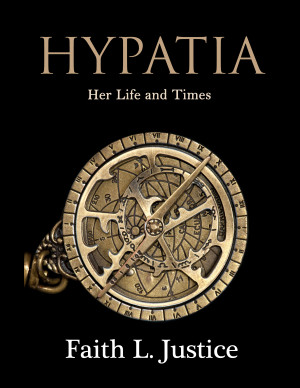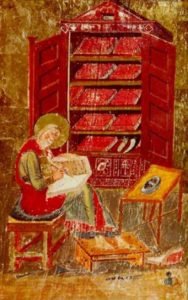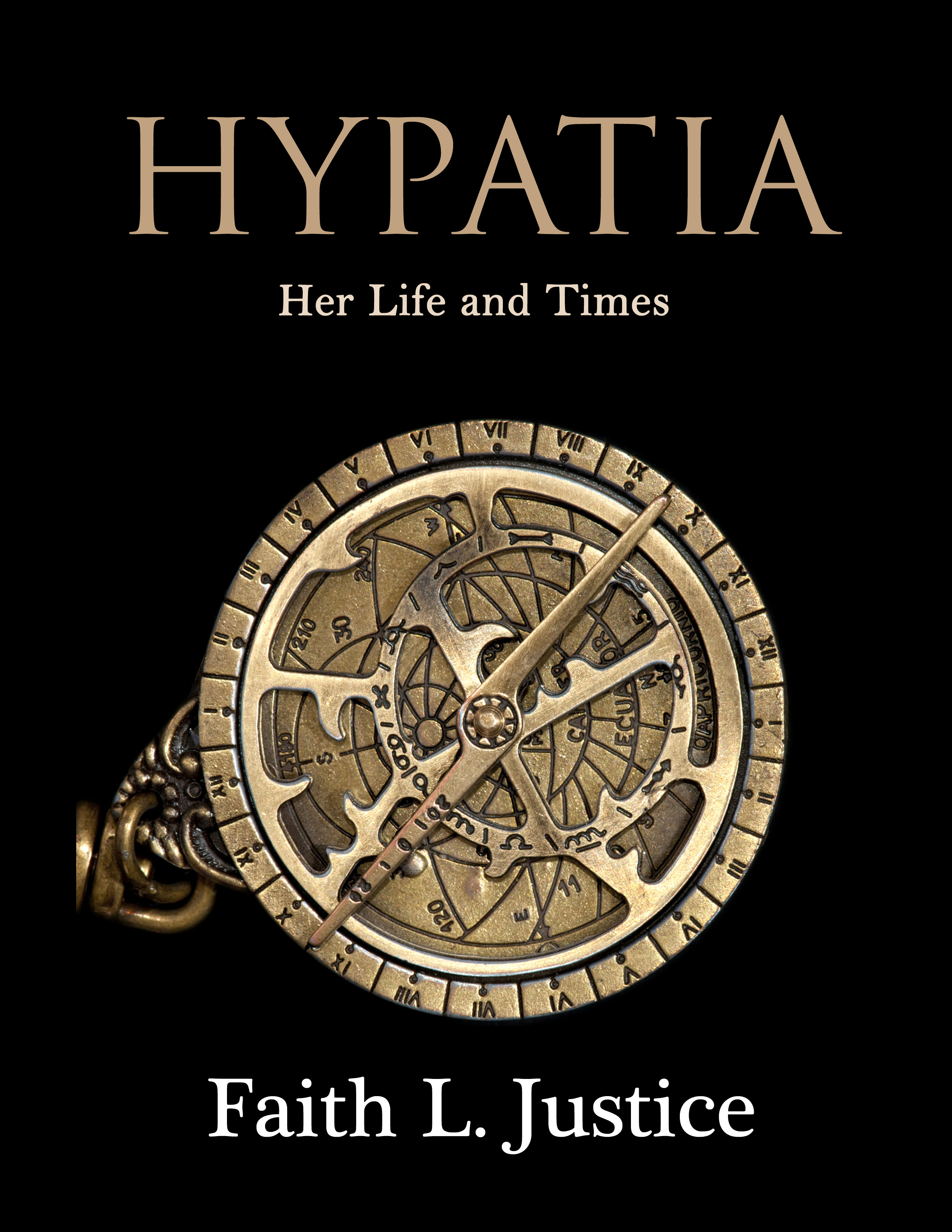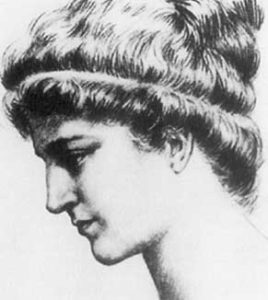
by fljustice | Mar 21, 2014 | Essays/Research, History, Hypatia, Wonderful Women
The Other Lady Philosophers

Hypatia from the “The School of Athens” by Raphael
It’s Women’s History Month and I’m back with the latest installment on my favorite Lady Philosopher, Hypatia of Alexandria. This year I’m tackling Hypatia’s sister philosophers. Hypatia didn’t spring from her father’s forehead fully girded and ready for combat in the primarily male world of Late Antiquity. There is a long history of lady philosophers—”lovers of wisdom”— down through the ages, and Hypatia is just one link in that chain. More than thirty-five women are attested to in the records leading up to, and contemporary with, Hypatia—and those are just the women whose heads (and intellect) rose above the crowd enough to be noticed by the decidedly biased ancient historians. One, ARETE of Cyrene (c 400/300 BCE ) ran a school of philosophy seven hundred years before Hypatia. Nine of those women studied (what early nineteenth century scholars later called) Neoplatonism. Two (that we know of) taught both men and women.
Since thirty-five is far too many women to profile, I’ll concentrate on the Neoplatonists and leave the rest for another post. (Please go to Women-philosophers.com, maintained by Kate Lindemann Ph.D., professor emerita at Mount Saint Mary College – Newburgh, New York, for overviews on more than 110 remarkable women philosophers.) When telling the stories of women scholars in history, it is impossible to separate them from their male relatives and teachers. A little context: the vast majority of people—men and women—until recent times, were illiterate, uneducated, and labored in agriculture and resource extraction. Only a small elite could afford education and that generally was reserved for the sons.
But not always.
History is filled with fathers who educated their daughters (including Theon and Hypatia). Because of genuine affection, they had no sons, or the girls were too brilliant to ignore—it didn’t matter. It happened. (Even today, research shows that a father’s encouragement distinctly improves the chances a girl will do well, and chose a career, in the STEM fields—science, technology, engineering and math.) Because the educated elite was such a small circle, these women tended to marry inside it (if they married) and have children that followed in their footsteps. If they didn’t teach directly, they educated their children, who did teach. So let’s take a look at the Neoplatonists and the extraordinary women who contributed to this philosophy’s development and dissemination.

by fljustice | Mar 26, 2013 | Essays/Research, History, Wonderful Women, Writing
Where Are All the Strong Women?
 Readers of this blog know I like to highlight fiction and non-fiction that present capable women with strong personalities. I read a post in a forum recently that intrigued me. The person was looking for historical fiction recommendations, but “none of those anachronistic modern women dressed up in historical costumes crap.” I don’t think s/he was disparaging time travel fiction and, yes, I’ve read a few stories where the women seem to have more modern sensibilities than might be warranted. But not all strong females in historical fiction are anachronistic. I’ve read other blog posts by historical fiction writers also deploring recent criticism about strong women described by readers as “too modern” in spite of ample historical evidence that women did and thought as the writers wrote them. Where does the dissonance come from? Why would a reader think a woman couldn’t be a doctor in Late Antiquity, captain a whaling ship, or teach men to fly planes during WWII — all documented events?
Readers of this blog know I like to highlight fiction and non-fiction that present capable women with strong personalities. I read a post in a forum recently that intrigued me. The person was looking for historical fiction recommendations, but “none of those anachronistic modern women dressed up in historical costumes crap.” I don’t think s/he was disparaging time travel fiction and, yes, I’ve read a few stories where the women seem to have more modern sensibilities than might be warranted. But not all strong females in historical fiction are anachronistic. I’ve read other blog posts by historical fiction writers also deploring recent criticism about strong women described by readers as “too modern” in spite of ample historical evidence that women did and thought as the writers wrote them. Where does the dissonance come from? Why would a reader think a woman couldn’t be a doctor in Late Antiquity, captain a whaling ship, or teach men to fly planes during WWII — all documented events?
I blame school history books. The protagonist in my novel, Selene of Alexandria is a young woman who wants to become a physician in fifth century Alexandria — not a “healer” or midwife — a trained and apprenticed physician. There is ample written and archaeological evidence of women physicians through the ages, including this period. But if you don’t look outside the traditional history texts, you wouldn’t know that. (more…)

by fljustice | Mar 15, 2012 | History, Hypatia, Wonderful Women
Hypatia of Alexandria: The Primary Sources
 It’s Women’s History Month, so here’s another Hypatia of Alexandria article! I’ve posted several in the past two years and put this one off, because it’s such a tricky one. As anyone who has studied Hypatia knows, there is little out there in the way of primary sources. Only a few pages come down to us from those times and almost none can be attributed to Hypatia, except a couple of technical works on mathematics and astronomy. (See my earlier post “Hypatia: Great Mathematician or Geometry Teacher?”) We don’t have much to go on; no diaries, no letters from her, nothing to tell us in her own words what her life was like. We have to rely on the witness of others. So who are these people and what ax did they have to grind (if any) in writing about Hypatia? For all those Hypatia fans out there, I’ve reviewed the four most extensive, and most quoted, primary sources and summarized what historians have generally come to believe about the motives of the authors. For organization’s sake, I’ll go chronologically, starting with one of my favorite characters from Hypatia’s story: Synesius of Cyrene. (more…)
It’s Women’s History Month, so here’s another Hypatia of Alexandria article! I’ve posted several in the past two years and put this one off, because it’s such a tricky one. As anyone who has studied Hypatia knows, there is little out there in the way of primary sources. Only a few pages come down to us from those times and almost none can be attributed to Hypatia, except a couple of technical works on mathematics and astronomy. (See my earlier post “Hypatia: Great Mathematician or Geometry Teacher?”) We don’t have much to go on; no diaries, no letters from her, nothing to tell us in her own words what her life was like. We have to rely on the witness of others. So who are these people and what ax did they have to grind (if any) in writing about Hypatia? For all those Hypatia fans out there, I’ve reviewed the four most extensive, and most quoted, primary sources and summarized what historians have generally come to believe about the motives of the authors. For organization’s sake, I’ll go chronologically, starting with one of my favorite characters from Hypatia’s story: Synesius of Cyrene. (more…)

by fljustice | Nov 9, 2011 | Essays/Research, History, Hypatia, Wonderful Women
Hypatia: Great Mathematician or Geometry Teacher?
 Hypatia, the Lady Philosopher of Alexandria, is best known for her gruesome murder at the hands of a mob in AD 415. Her martyrdom takes pride of place in the historical narrative of many groups including mathematicians and scientists. I’ve written extensively about my search for the “real” Hypatia and the politics surrounding her death. I’m still fascinated and set up a Google Alert on her name, so I can participate in online discussions. Mostly I get hits on her namesake philosophy magazine (they’re looking for a new editor), the digital archival materials software (recently released version 0.8.0) and the woman who blogs about her cat (Hypatia doesn’t like the new kittens.) About once or twice a month there will be a post from a student at some public Q&A site, “So I’m doing a paper on Hypatia. I heard she invented the hydroscope and helped her dad with his math book. What else did she do?”
Hypatia, the Lady Philosopher of Alexandria, is best known for her gruesome murder at the hands of a mob in AD 415. Her martyrdom takes pride of place in the historical narrative of many groups including mathematicians and scientists. I’ve written extensively about my search for the “real” Hypatia and the politics surrounding her death. I’m still fascinated and set up a Google Alert on her name, so I can participate in online discussions. Mostly I get hits on her namesake philosophy magazine (they’re looking for a new editor), the digital archival materials software (recently released version 0.8.0) and the woman who blogs about her cat (Hypatia doesn’t like the new kittens.) About once or twice a month there will be a post from a student at some public Q&A site, “So I’m doing a paper on Hypatia. I heard she invented the hydroscope and helped her dad with his math book. What else did she do?”
I realized many people (not just students) are puzzled over Hypatia’s contributions to math and science. There’s a lot of magical thinking about her life and work. The movie Agora used a mythical search for heliocentrism (the sun as the center of the solar system vs. the Ptolemaic earth-centered view, held by most people at the time) as a metaphor for Hypatia’s scientific thinking. So what did she do? Did she discover any important scientific or mathematical principles? Was she merely a glorified teacher who would be lost to history except for her extraordinarily brutal death? Here’s my best take on Hypatia’s contributions…and students remember this is copyrighted material; no cutting and pasting for your papers, but feel free to check out the reference at the end, quote and attribute! (more…)

by fljustice | May 11, 2011 | Essays/Research, History, Hypatia
Alexandria: The Early Years
 Alexandria has always fired my imagination. It’s the setting for my novel Selene of Alexandria. I’ve written about its Great Library and Cleopatra’s Needle, an obelisk from the Caesarian that sits in New York’s Central Park. Alexandria is fascinating and complicated, with a reputation for learning and a history of violence. It was in the news as Muslims attacked Christians, harking back to the bad old days of the fourth and fifth centuries. The next month, young people of all faiths formed a human chain around its museums and library, protecting those vulnerable institutions during the Egyptian uprising. In ancient times, as today, it was a major port and the gateway to the rest of Egypt. A diverse city of many religions, where people from all over the world come to work, trade, study and enjoy the culture. You could think of it as the Manhattan of the East, but maybe Manhattan should be known as the Alexandria of the West. After all, Alexandria did come first. (more…)
Alexandria has always fired my imagination. It’s the setting for my novel Selene of Alexandria. I’ve written about its Great Library and Cleopatra’s Needle, an obelisk from the Caesarian that sits in New York’s Central Park. Alexandria is fascinating and complicated, with a reputation for learning and a history of violence. It was in the news as Muslims attacked Christians, harking back to the bad old days of the fourth and fifth centuries. The next month, young people of all faiths formed a human chain around its museums and library, protecting those vulnerable institutions during the Egyptian uprising. In ancient times, as today, it was a major port and the gateway to the rest of Egypt. A diverse city of many religions, where people from all over the world come to work, trade, study and enjoy the culture. You could think of it as the Manhattan of the East, but maybe Manhattan should be known as the Alexandria of the West. After all, Alexandria did come first. (more…)








